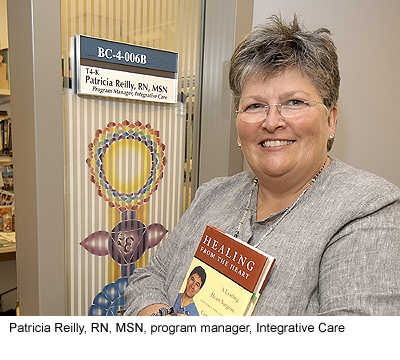The Power to Heal

In the world of highly advanced technology, sometimes the very basics can be the most beneficial. As much as traditional methods of treatment promote healing and recovery, integrative or complementary methods have been making their way into conventional approaches of patient care.
As a way to integrate complementary therapies into nursing practice at BWH, Patricia Reilly, RN, MSN, program manager for Integrative Care, was hired in 2002. During her nearly 35 years in nursing, including leadership roles in perioperative and critical care nursing at Boston teaching hospitals, Reilly began to clearly see the nurse's role as a healer. She now educates BWH nurses on ways to utilize the tools and modalities to help patients the recovery process and in managing their pain and illness.
“Florence Nightingale wrote that 'the nurse becomes the healing environment for the patient.' We must all understand that who we are and what we are thinking as we care for our patients affects them tremendously. We can visualize our patients as healed and healthy so that they know, believe and feel that it is possible,” said Reilly.
In addition to participating and consulting on patient cases, Reilly teaches a full portfolio of complementary therapies to nursing staff, including Therapeutic Touch and Reiki, meditation, Guided Imagery and others. She is also a member of the Harvard Medical School Integrative Care Group at BWH, composed of both Eastern and Western physicians and practitioners, currently using a NIH grant to study lower back pain. Harvard, BWH and a growing number of academic and health care organizations are recognizing and supporting the benefits of integrative therapies and training clinicians to carry out these compassionate methods.
The collection of methods taught by Reilly and others helps caregivers and patients focus their energy. “Meditation for instance is about quieting the mind and focusing one's attention on the breath. Quieting the mind is the first step in managing your energy for your own individual health and for the practice of complementary healing interventions,” said Reilly, who first became interested in complementary and integrative therapies while going through a particularly stressful point in her career.
Years after enrolling and completing a stress management course offered by
Jon Kabot-Zinn at UMass Boston, she began to educate others. Part of her work in this field involved practicing meditation with pediatric patients at the Children's Floating Hospital of New England Medical Center (NEMC). In the early 1990s she began learning other healing/energy techniques and was gratified by the positive results she experienced with coworkers, patients and herself.
Now at BWH, Reilly has led research on stress reducing methods with nurses and has found that such methods bring about favored results for the nurses as caregivers and, in turn, their patients.
Reilly's expertise is also being sought by hospital leadership. She is serving on one of the six planning committees to assist with the design of the Carl J. and Ruth Shapiro Cardiovascular Center slated to open at 70 Francis St. in 2008. BWH's goal is to design the new building in a way that best promotes healing.
“We as nurses must realize our critical role in healing. What we think, we create. By visualizing the ill or recovering patient as a strong, healthy individual, we further contribute to his or her healing,” said Reilly.